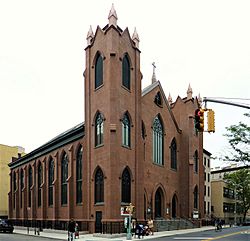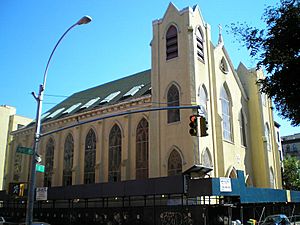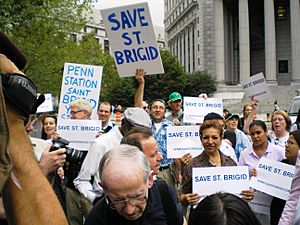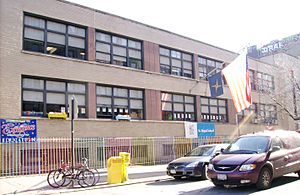St. Brigid Roman Catholic Church (Manhattan) facts for kids
Quick facts for kids St Brigid's Roman Catholic Church |
|
|---|---|

(2013)
|
|
| 40°43′31.5″N 73°58′50.5″W / 40.725417°N 73.980694°W | |
| Location | 123 Avenue B, Manhattan, New York City |
| Country | United States |
| Denomination | Catholic Church |
| Tradition | Latin Church |
| History | |
| Status | Church |
| Dedication | St Brigid |
| Earlier dedication | May 25, 1879 |
| Consecrated | January 27, 2013 |
| Architecture | |
| Functional status | Active |
| Architect(s) | Patrick Keely |
| Architectural type | Carpenter Gothic |
| Style | Decorated Neo-Gothic |
| Specifications | |
| Number of spires | 1 |
| Materials | stone |
| Bells | 2 |
| Administration | |
| Archdiocese | Archdiocese of New York |
St. Brigid's Roman Catholic Church, also known as St. Brigid's or the Famine Church, is a historic church in Manhattan, New York City. It is located at 123 Avenue B, near Tompkins Square Park in the East Village neighborhood.
Since 1856, a school called Saint Brigid School has been connected to the church. It teaches students from Pre-K through 8th grade. St. Brigid's Church has a long and interesting history, starting in 1848. In 2013, another church, St. Emeric Church, closed. Its parish joined with St. Brigid's. The church is now known as St. Brigid-St. Emeric Church.
Contents
History of St. Brigid's
The church parish was started in 1847. Construction began in 1848. Irish shipbuilders, who were skilled workers, helped build it. Many Irish people were coming to New York at that time, fleeing the Great Irish Famine (1845–1849). The church was designed by Patrick Keely. He even carved some of the beautiful wooden decorations himself. Bishop John Hughes officially opened the church on December 2, 1849.
In its early years, St. Brigid's was a safe place for Irish immigrants. Later, it welcomed many other immigrant groups. These included Polish, Germans, Ukrainians, and Puerto Ricans.
Father Mooney and the 69th Regiment
The second pastor of St. Brigid's was Reverend Thomas Mooney. He also served as a chaplain for the 69th New York State Militia. This group was formed in 1851 and was made up of Irish-Catholic volunteers. Father Mooney traveled with the 69th Regiment and was well-liked by the soldiers. He held daily Masses and offered guidance to the mostly Catholic regiment.
Father Mooney was called back to New York by Archbishop John Hughes. This happened after some unusual events, including Father Mooney trying to fix an American flag that got stuck. The soldiers of the 69th Regiment were sad to see him go. However, Father Mooney received a warm welcome from 4,000 church members when he returned to New York City.
During the New York City draft riots in July 1863, Father Mooney helped organize a local group. This group worked to counter federal troops sent to New York. When the 69th Regiment returned to New York, Father Mooney marched with them. A special Mass was held on August 14, 1861, for the soldiers who had died in battle. Father Mooney was always present at events for the Irish Brigade. He was remembered fondly by the soldiers who survived.
In 1901, a newspaper article mentioned St. Brigid's Church. It noted that the upper part of the church was used by Irish people. The basement was used by Italian immigrants. There was also a convent for the Sisters of Charity next door and a school. As the number of Irish people in the area changed, St. Brigid's continued to serve new immigrant groups. These included Slavs and Italians in the late 1800s. From the 1950s onward, it served the growing Latino community.
Father Kuhn and Community Support
During the 1988 Tompkins Square Park Riot, St. Brigid's Church offered help. It allowed people who supported the homeless and protested police actions to gather inside. A year later, a temporary shelter in the park was removed. The church's pastor, Reverend George Kuhn, led a group of church members. They took food to protesters and homeless people who were staying in an abandoned school.
Father Kuhn was arrested when he crossed a police line to deliver food. He said he had orders "to feed the hungry" from a "higher authority." St. Brigid's Church was a place where protesters could organize. They could also receive medical help during the riot.
Church Closure and Reopening
The main church building closed in 2001 because of a large crack. The back wall was pulling away from the rest of the building. Church services were then held in the nearby school. The church members worked hard to raise money to save the building.
In 2004, the Archdiocese of New York officially closed the church. Demolition began in 2006. A spokesperson for the Archdiocese said the building was unsafe. They also said the property would not be sold for apartments. The plan was to use it for other church activities, like education or charity. Some people criticized how the Archdiocese handled the situation.
In 2006, a judge allowed demolition plans to move forward. However, later that year, the judge agreed to hear another lawsuit. This lawsuit argued that the church's ownership and right to demolish were not valid. On July 26, 2006, the judge did not stop the demolition plans. Before arguments could be heard, a demolition crew arrived. They made a hole in the back wall and damaged the inside. At least one stained glass window was also damaged. This window showed scenes from Jesus' life and had names of Irish Famine victims. The next day, workers removed more stained glass windows.
Community leaders, including City Councilmember Rosie Mendez, spoke out against the demolition. They accused the Archdiocese of being greedy. However, the Archdiocese said the demolition was not about money. They repeated that they had no plans to sell the property. On August 24, 2006, the judge ordered a stop to the demolition.
A New Beginning
On May 22, 2008, the Archdiocese of New York announced good news. They had received a "very welcome gift" of $20 million from an anonymous donor. This gift included $10 million to fix the church building. Another $2 million was for the parish to help meet the community's needs. The remaining $8 million was to support St. Brigid’s School and other Catholic schools. Cardinal Edward M. Egan, the archbishop of New York, thanked the donor. He said the gift would allow St. Brigid’s Church to be beautifully restored.
On January 27, 2013, the newly renovated church was officially opened. Many people attended, including descendants of the original Irish church members. With the church restored, St. Emeric Church on Avenue D closed. Its parish joined with St. Brigid's. The new parish is now called "St. Brigid-St. Emeric."
Architecture of St. Brigid's
St. Brigid's was built in 1848. It was designed in a style called Carpenter Gothic by Patrick Keely. He was only 25 years old at the time. Keely carved many parts of the church himself, including the altar.
Outside the Church
The church is made of brownstone. Its front has three parts and is flanked by bell towers. These towers once had tall spires, but they were removed in 1962 for safety reasons. The wide main area inside the church has a unique ceiling. It looks like an upside-down ship's hull. This design honors the shipwrights who helped build the church. Their faces are carved into the decorations. In 1877, the wooden beams in the towers were replaced with iron because they were decaying.
Inside the Church
The oil paintings showing the Stations of the Cross were bought in Paris in the 1870s. They are believed to be by an artist named Théophile-Narcisse Chauvel. The beautiful stained glass windows came from Bavaria. At that time, a carved marble altar replaced the original wooden one.
The Archdiocese hired Michael F. Doyle to oversee the renovations. Stucco was removed from the stone outside. The building's foundations were made stable. The remaining stained glass windows were put back in place. More stained glass was moved from St. Thomas the Apostle Church in Harlem, which had closed in 2003. The restoration project won an award in 2013 for its excellent work.
St. Brigid's School
Reverend Thomas Mooney, the pastor of St. Brigid's, started the school in 1856. It was in a part of the Lower East Side with many Irish immigrants. At first, classes were held in the church basement. A school building was built and opened in 1858. It was located on 8th Street. The Christian Brothers taught the boys. The Sisters of Charity taught the girls. Father Mooney also asked the Sisters of Charity to open St. Brigid's Academy for girls.
By 1934, the school building was in poor condition. The Great Depression also made it hard to keep the school open, so it closed. After World War II, in the 1950s, more families moved to the parish. This led to a new school building being built. The new building opened on September 12, 1954, with 124 students. It was dedicated by Cardinal Francis Spellman in 1955. The old school building was torn down in 1970.
In the 1990s, the school faced challenges. The number of students dropped significantly. Father Kuhn, the pastor at the time, said it was due to poverty in the area. However, some parents were upset because the popular principal and some teachers were fired. In the 1990s, the Sisters of Charity stopped teaching at the school.
In 1995, a spokesperson for the Archdiocese said that the Cardinal strongly supported the school. From 1995 until the church closed in 2004, the parish and school were run by the Trinitarians. In 2006, the school started a partnership with St. John's University. This partnership helped students improve their test scores in reading and math.
In 2010, about 120 students were enrolled in the school. However, on July 15, 2019, St. Brigid's School closed permanently.
See also




